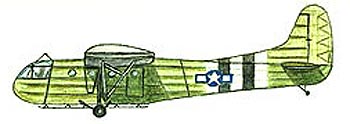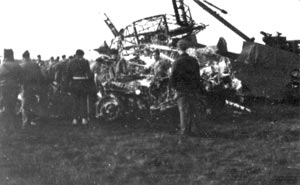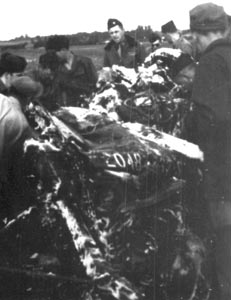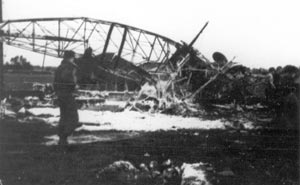Mid
Air Collision Between Two Waco CG4A Gliders
82nd Troop Carrier Squadron, 436th Troop Carrier Group, US 9th Air Force
Strouds Farm, Lambourn Woodlands
19th September 1944

On Sunday 17th September 1944 the allies launched their invasion of Holland, codenamed 'Market Garden'. The 436th Troop Carrier Group at Membury was heavily involved, dropping paratroopers from the 101st Airborne Division near Zon on D-Day, and towing gliders to landing zones in the Eindhoven area on D+1 and D+2.
Men from the 1st Battalion, 327th Glider Infantry Regiment, 907th Field Artillery Battalion and 326th Engineers were scheduled to fly the final D+2 mission and were waiting in company with their glider pilots - tension was high. In spite of the outward appearance of calm, the men were edgy and tense; it didn’t take much to start a fistfight. On the airfield at Membury Flight Officer Kenneth Hinkel and Second Lieutenant Adolf Riscky had been drinking quietly together until an incautious word had set them throwing punches at each other. As someone explained, “It was a mixture of nerves and a fairly large bottle of Beefeater gin.” The bystanders let them work off some energy and their dislike for each other until a Thompson submachine gun got into the act, and then they quickly stepped in and broke it up. Both Hinkel and Riscky had already crash-Ianded in Normandy and southern France, and their anxiety about the coming operation was building. Hinkel, the youngest glider pilot in the squadron, had long had a premonition about this mission. In ltaly, before taking off for southern France, he had said that “he’d make out in that one, but wouldn’t survive another invasion” Flight Officer Douglas Smith recalled - “He was just a kid. He cried softly all night before the takeoff. Riscky was strangely quiet” The above is an extract from "The Glider Gang" and has been reproduced with the kind permission of the book's author Mr Milton Dank.
Bad weather seriously disrupted the missions flown on the 19th (D+2), but of the 41 gliders in the first serial most were delivered to their landing zones on schedule. However the second serial, consisting of 40 CG4A gliders and their tug aircraft, had to abandon the mission and return to base. The aircraft had been flying through a solid bank of cloud and for most of the journey the glider pilots were unable to see their tow planes. The call to return was received by the formation midway across the English channel.
Because of a serious shortage of glider pilots the CG4As were being flown without co-pilots. As the aircraft and glider combinations returned to Membury so the gliders would, one by one, break from their tow planes and manoeuvre into position, before landing on the grass infield of the aerodrome.
It was during this part of the aborted mission, at about 16:10 hours, that two gliders from the 82nd Troop Carrier Squadron collided. Both aircraft were on their downwind leg when they tragically came together, falling into a field close to Membury's base hospital. Both gliders were carrying men, equipment and supplies from the 327th Glider Infantry Regiment, 101st Airborne Division, and all eight occupants died instantly upon impact with the ground. The official crash report stated that 'although exactly what happened is unknown, visibility was good at the time and carelessness on one or other (of the pilots) part caused their deaths'. The following is a further extract from "The Glider Gang" by Milton Dank and is once again reproduced with his kind permission. As they approached the field under a low, threatening ceiling, Second Lt. Robert Dopita, the co-pilot of one of the tugs, saw a tragic scene. Two Waco gliders that had released ahead of his plane and were now flying just below him at an altitude of less than 700 ft. suddenly turned and rammed head on. For a split second the two intermingled gliders seemed to hang in the air and then broke apart. A Jeep - its driver still sitting rigid at the wheel and his passenger slumped beside him - tore out the front of one of the gliders and tumbled to the ground. Bodies spilled out from the wreckage like toy soldiers out of a great box, turning over and over, arms and legs outspread as they fell. The two gliders crashed a short distance apart, and one of them burst into a brilliant white flame from the phosphorous shells it had been carrying. Hot tempered words and threats over a "bottle of Beefeater gin" had come true. By a startling coincidence, Hinkel and Riscky had killed each other - and had taken six gliderborn troopers with them. Listed below are the names of those who lost their lives:-
CG4A
glider serial number 42-79263
Pilot - F/O Kenneth. B. Hinkel
Passenger - Cpl. Stanley. A. Cynkar (907th GFAB)
Passenger - Pfc. George. W. Hilton (907th GFAB)
Passenger - Pvt. Jess. L. Riggs (907th GFAB)
CG4A glider
serial number 42-56215
Pilot - 2nd Lt. Adolf Riscky
Passenger - Sgt. R. A. Dickman (907th GFAB)
Passenger - Pfc. Dan McFarlan (907th GFAB)
Passenger - Pvt. Ernest McMurty (907th GFAB)
Below: The twisted remains of the two Waco gliders. In amongst the wreckage can be seen a 907th GFAB Jeep, part of the cargo from one of the aircraft.



©
Copyright 2004 Roger Day